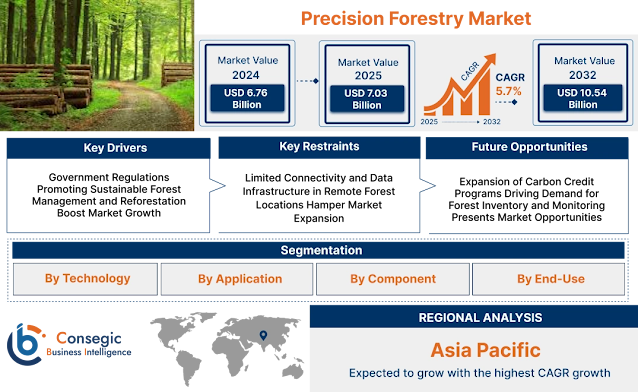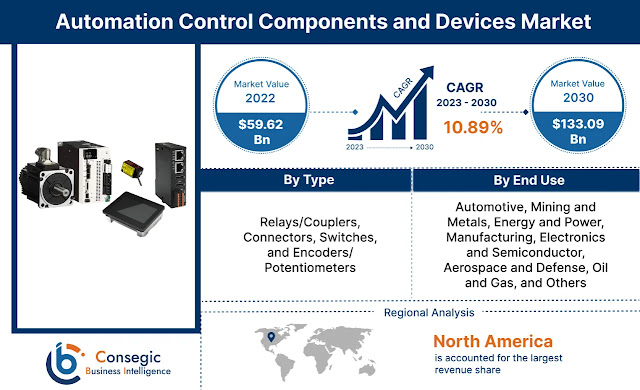Precision Forestry Market: Where Technology Meets Sustainable Timber
The Precision Forestry Market is on track for impressive growth. Estimated at USD 6.76 billion in 2024, the market is projected to reach USD 7.03 billion in 2025, scaling to over USD 10.54 billion by 2032. This expansion, at a CAGR of 5.7% from 2025 to 2032, underscores a significant shift in forestry from manual operations to digitally enabled systems.
This trajectory reflects more than just adoption—it signals rising investments in smart equipment, AI-powered analytics, and sustainable forestry certification processes. Stakeholders are recognizing the value of maximizing yield while minimizing ecological impact, further accelerating innovation and adoption.
What’s Driving the Market?
Several key trends are fueling the rapid growth of the precision forestry sector:
-
Technological Innovations: The integration of GPS, LiDAR, drones, and GIS mapping into forestry operations is transforming how forests are measured, harvested, and maintained.
-
Sustainability Mandates: Governments and global organizations are pushing for sustainable forestry to meet environmental and carbon offset goals.
-
Increased Industrial Demand: Rising demand for timber, biomass, and forest-based products is pushing companies to optimize yield without depleting resources.
-
Data-Centric Decision-Making: Cloud-based platforms and real-time analytics are enabling foresters to make smarter, faster, and more cost-effective decisions.
Drivers, Restraints, and Opportunities
Drivers
-
Rising environmental regulations demanding traceable and sustainable forestry.
-
Cost reduction through automated data collection and analysis.
-
Technological accessibility—affordable drones, better connectivity, and intuitive software.
Restraints
-
High upfront costs for advanced machinery and digital platforms.
-
Lack of skilled personnel to operate precision tools in rural or developing regions.
-
Limited digital infrastructure in remote forest areas.
Opportunities
-
Growing adoption in emerging economies.
-
Integration with carbon credit trading and sustainability certifications.
-
Expansion of AI-powered forestry models for pest control, growth prediction, and yield optimization.
Market Segmentation
By Technology
-
Remote Sensing
-
GIS (Geographic Information Systems)
-
GPS (Global Positioning Systems)
-
Telematics
-
Drones/UAVs
-
LiDAR
-
Others
By Application
-
Forest Management and Planning
-
Precision Silviculture
-
Wildlife Habitat Management
-
Carbon Sequestration
-
Genetics and Nurseries
-
Fire Management
-
Harvesting Management
-
Inventory & Logistics Management
By Component
-
Hardware
-
Software
-
Services
By End-Use
-
Industrial Forests
-
Commercial Plantations
-
Government & Community Forestry
-
Academic & Research Institutes
-
Forestry Contractors
-
Others
Segmentation Insight: This multi-layered segmentation offers a comprehensive lens into the market, helping stakeholders understand technology trends, functional demand, and consumer priorities across end-user profiles.
Segmental Opportunities
Largest Subsegment:
Forest Management and Planning remains the largest segment due to the critical role it plays in resource allocation, yield forecasting, and sustainability compliance. Large-scale industrial players prioritize this function to balance profit with environmental stewardship.
Fastest-Growing Subsegment:
Drones/UAVs are witnessing the fastest adoption. Their ability to collect real-time aerial imagery, detect changes in canopy health, and monitor biodiversity with minimal labor makes them indispensable in both commercial and governmental forestry operations.
Regional Trends
North America
Pioneering precision forestry adoption, with strong R&D capabilities and government funding for sustainable practices. The region also benefits from a mature commercial plantation sector and widespread digital infrastructure.
Asia-Pacific
The fastest-growing region, driven by rapid urbanization, deforestation concerns, and government support for smart agriculture and forestry technologies. Countries like China and India are ramping up satellite monitoring and drone integration.
Europe
Focuses on eco-conscious forestry, aligned with the EU’s green deal and net-zero targets. High adoption of LiDAR and GIS for sustainable forest planning.
Latin America & Middle East & Africa
Emerging markets, with growing awareness of deforestation control, carbon management, and land-use efficiency. Government partnerships with NGOs and foreign investors are driving digital adoption.
Challenges and Innovation
Challenges
-
High equipment and software costs, especially in lower-income regions.
-
Limited digital literacy in forest management teams.
-
Terrain and connectivity issues hampering real-time data transmission.
Innovations
-
IoT-powered sensors to gather forest data in remote environments.
-
Cloud-based forestry platforms to centralize analytics and improve collaboration.
-
Modular, scalable hardware that reduces cost barriers and enhances accessibility.
Top Key Players in Precision Forestry Market Market
-
Deere & Company (USA)
-
Trimble Inc. (USA)
-
Raven Industries (USA)
-
Tigercat International Inc. (Canada)
-
Ponsse Plc (Finland)
-
Komatsu Forest AB (Sweden)
-
Treemetrics Ltd. (Ireland)
-
Rottne Industri AB (Sweden)
-
Ecolog (Sweden)
-
Sampo Rosenlew Ltd. (Finland)
Outlook: What’s Ahead?
Precision forestry is fast evolving from a niche technology into a mainstream necessity for both commercial plantations and conservation agencies. The next decade will see:
-
Increased digital integration with satellite systems, AI models, and sustainability frameworks.
-
A shift toward subscription-based software platforms that democratize access to advanced analytics.
-
Customizable, plug-and-play hardware solutions for small- to mid-sized forestry operators.
Ultimately, precision forestry is not just a tool—it’s a strategic imperative for ensuring that forests remain productive, profitable, and preserved.
FAQs
Q1: What is the current market size and future forecast for the Precision Forestry Market Market?
A1: The market is valued at USD 6.76 billion in 2024 and projected to reach USD 10.54 billion by 2032, growing at a CAGR of 5.7% from 2025 to 2032.
Q2: Which segment leads the market?
A2: Forest Management and Planning is currently the largest segment due to its essential role in optimizing long-term yield and compliance.
Q3: Which region shows the fastest growth?
A3: Asia-Pacific is the fastest-growing region, driven by rapid urbanization, environmental regulations, and government-supported forestry tech programs.
Q4: What innovations are driving the market forward?
A4: Drone technology, IoT sensors, cloud-based analytics, and AI-driven forest modeling are revolutionizing how forests are managed and protected.




Comments
Post a Comment